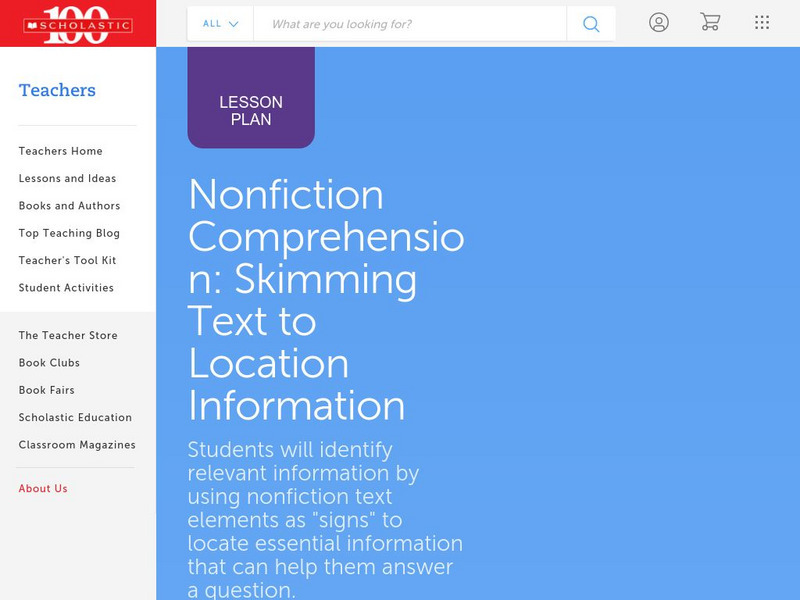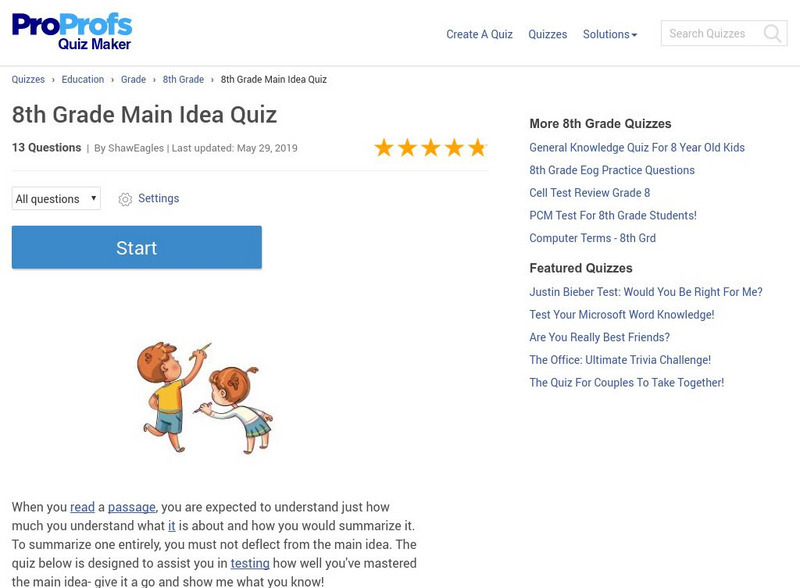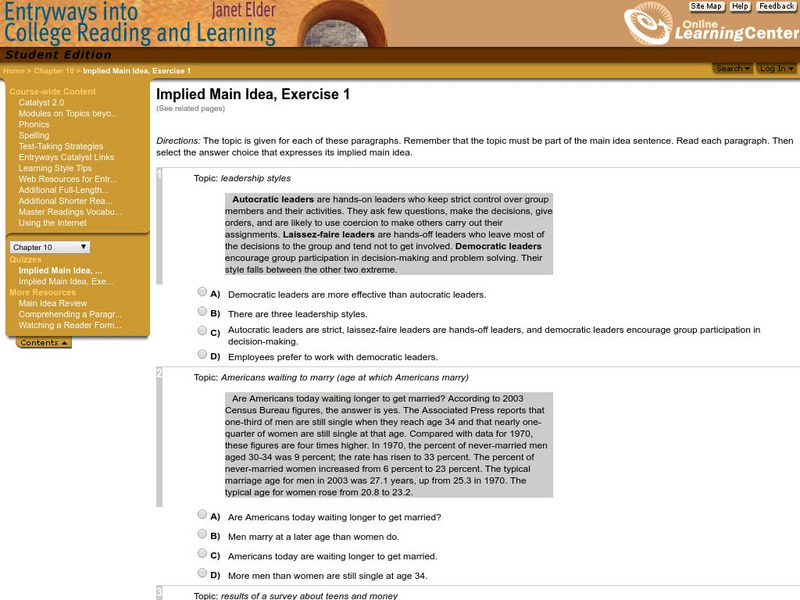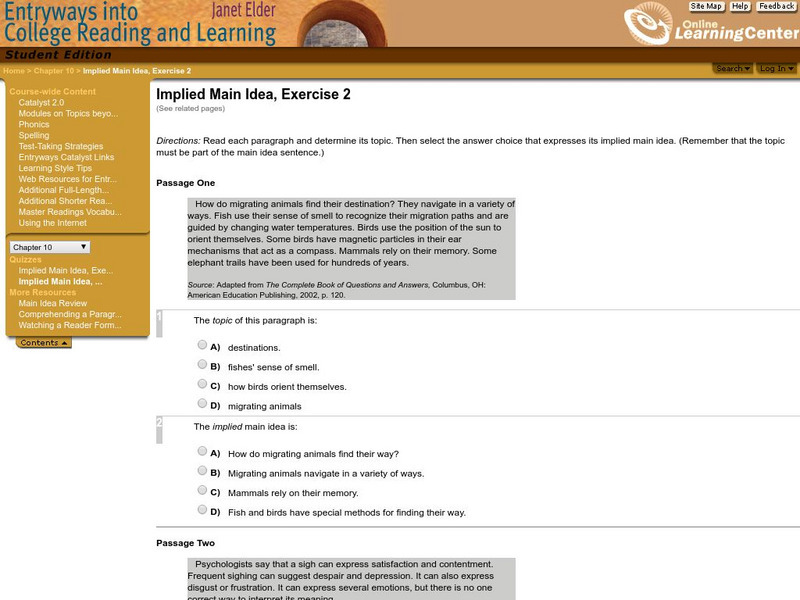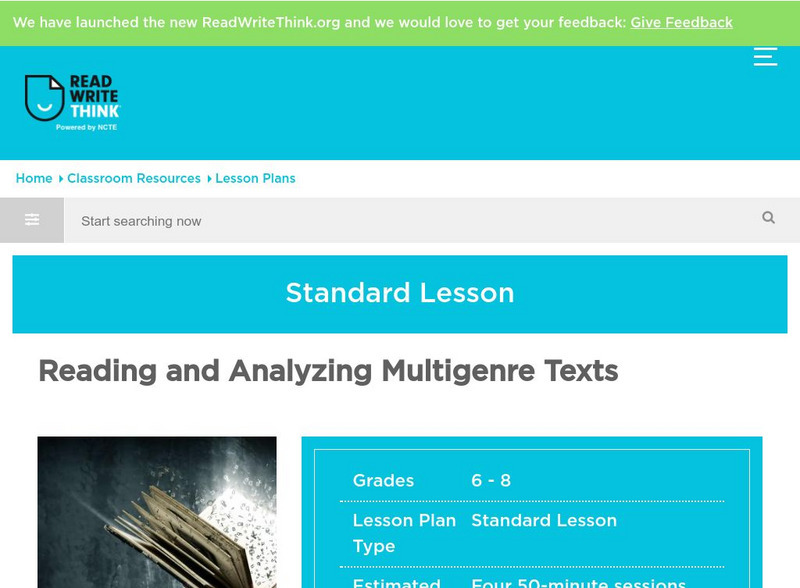Scholastic
Scholastic: Lesson Plan for Nonfiction Comprehension: Skimming Text
Build comprehension by developing reading strategies for use with nonfiction text. This lesson focuses on teaching students to recognize text elements as clues to help them quickly locate key information in text.
ProProfs
Pro profs.com: 8th Grade Main Idea Quiz
An interactive quiz with four short passages and thirteen multiple choice and extended response questions focusing on main ideas and supporting details. Students can access all passages and questions without an account, but a free...
E Reading Worksheets
E Reading Worksheets: Summarizing Worksheets and Activities
In this instructional resource, students will learn more about summarizing texts. Worksheets and PowerPoint lessons are provided to reinforce understanding about ways to summarize nonfiction texts and to identify main ideas. This module...
Wisconsin Response to Intervention Center
Wisconsin Rt I Center: Text Dependent Questions [Pdf]
Describes a reading strategy where students must respond to text by supporting their ideas with text-based evidence. Lists different categories of questions the teacher can prepare based on the text chosen, with examples for each.
Curated OER
Mc Graw Hill: Part 2 Reading: Determine Main Ideas and Supporting Details
See how to pick out the main ideas and supporting details on this site. Click on Model at the bottom right.
Curated OER
Mc Graw Hill: Part 2 Reading: Determine Main Ideas and Supporting Details
See an example of how to determine the main ideas and supporting details of a story.
E Reading Worksheets
E Reading Worksheets: Patterns of Organization: Order of Importance
This site provides an explanation of the order of importance text structure. A diagram is provided to provide to supplement the explanation.
Grammarly
Grammarly Handbook: Patterns of Organization for Academic Texts
A list of six different ways to organize a text with links to more information for each.
Polk Brothers Foundation Center for Urban Education at DePaul University
De Paul University: Center for Urban Education: I Can Infer Character Traits and Support [Pdf]
Students can use this graphic organizer while making inferences about characters in a story or history text. Students will collect text evidence in the chart to support their character trait inferences.
Polk Brothers Foundation Center for Urban Education at DePaul University
De Paul University: Center for Urban Education: Expand Story or History Text Based Dialog[pdf]
Students will use graphic organizers to help them make inferences about historical figures' feeings and motives. Students will summarize the information during an extension activity.
McGraw Hill
Mc Graw Hill: Informational Text: Determine Central Idea and Supporting Details
To understand a text, you must understand the central idea of the story. Learn how to recognize the central idea and supporting details with this article. Click the links at bottom right.
Other
Text Help: Middle Grades Informational Text [Pdf]
A useful resource with ideas for teachers to meet the Common Core Standard 8.3 for informational text. The ideas are designed for use with the program Read and Write Gold, but could be implemented on paper.
McGraw Hill
Mc Graw Hill Global Education: Implied Main Idea, Exercise 1
Take this five question self-correcting quiz to test your understanding of the implied main idea.
McGraw Hill
Mc Graw Hill Global Education: Implied Main Idea, Exercise 2
Take this five-question self-correcting quiz to test your understanding of the implied main idea.
ReadWriteThink
Read Write Think: Get the Gist: A Summarizing Strategy for Any Content Area
A five-part standards-based lesson plan in which students learn to write a 20 word summary of an informational text by focusing on answering the questions who, what, when, where, why, and how. This strategy can be applied to any content...
ReadWriteThink
Read Write Think: The Big Bad Wolf: Analyzing Point of View in Texts
In this lesson, students will research a fairy tale and analyze it based on the point of view. CCSS.ELA-Literacy.CCRA.R.6
ReadWriteThink
Read Write Think: Reading and Analyzing Multigenre Texts
This lesson plan deals with the process of analyzing a variety of literary texts from poetry and letters to diary entries and works of fiction. Included in the lesson plan is an overview, practice, objectives, resources, preparation, and...
Other
Writing & Reading Success Center: Summarizing Paragraphs [Pdf]
An explanation and example of summarizing a paragraph, especially helpful for taking notes on texts.
Other
English Companion: Reading Expository Text
Taken from "Reading Reminders: Tools, Tips, and Techmiques," the information on this website provides advice on how to read, understand, analyze, and write expository texts.
Other
Reading Quest: Strategies for Reading Comprehension: Power Thinking
Looking for an alternative to formal outline instruction? Power Thinking teaches the concept of outlining but on a somewhat simplified level. The site is good for basic note-taking from a text.
ReadWriteThink
Read Write Think: Character, Conflict, Resolution, Setting
This interactive activity allows young scholars to study and analyze the text concepts of character, conflict, resolution, and setting in a "Broadcast news," format.
Education Development Center
Tune in to Learning: Summarizing
Series of interactive activities for practicing skills in summarizing information, in identifying main points and ideas, and in sorting lists into meaningful categories.
E Reading Worksheets
E Reading Worksheets: Character Traits Project
In this learning module, students will learn more about learn more about character traits. Directions and rubrics for a group project are provided to reinforce the understanding of character traits. This module is designed to support...
E Reading Worksheets
E Reading Worksheets: Patterns of Organization: Problem and Solution
This learning module provides an explanation of the problem and solution text structure. An explanaton of the problem and solution text structure is provided, and comparisons to the cause and effect text structure are demonstrated in a...


